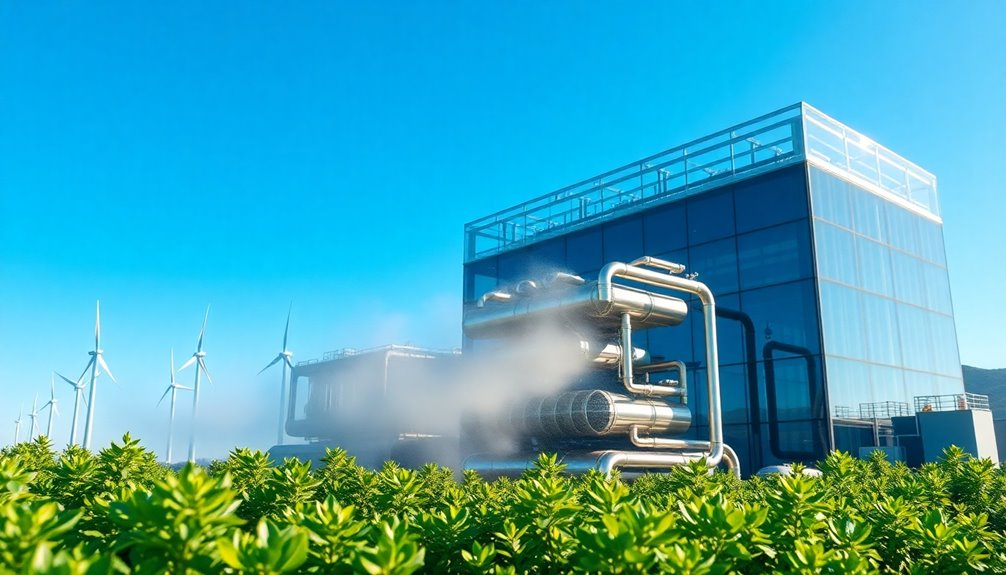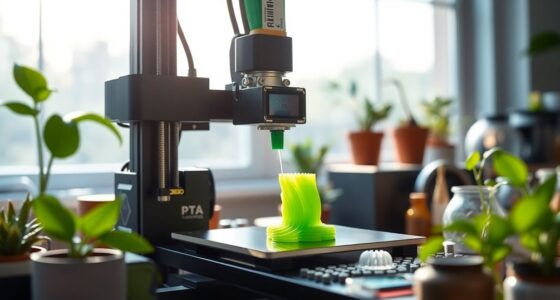Innovations in carbon capture technology are transforming the way we combat climate change. You'll find advanced materials like metal-organic frameworks and specialized amine solutions improving CO2 absorption efficiency. Direct air capture (DAC) systems allow for the removal of CO2 straight from the atmosphere. These developments don't just help reduce emissions; they also turn captured carbon into valuable products like synthetic fuels and building materials. Discover how these advances can impact our future and the economy.
Key Takeaways
- Development of metal-organic frameworks (MOFs) enhances CO2 absorption efficiency and selectivity through high surface area and tunable structures.
- Advanced amine solutions improve reaction kinetics, allowing for faster CO2 absorption in various capture processes.
- Utilization of membranes for gas separation offers innovative approaches to enhance carbon capture technologies.
- Direct air capture (DAC) technology provides a proactive method for reducing atmospheric CO2 levels by capturing emissions directly from the air.
- Repurposing captured carbon into synthetic fuels and building materials supports a circular economy and drives economic growth.
The Science Behind Carbon Capture
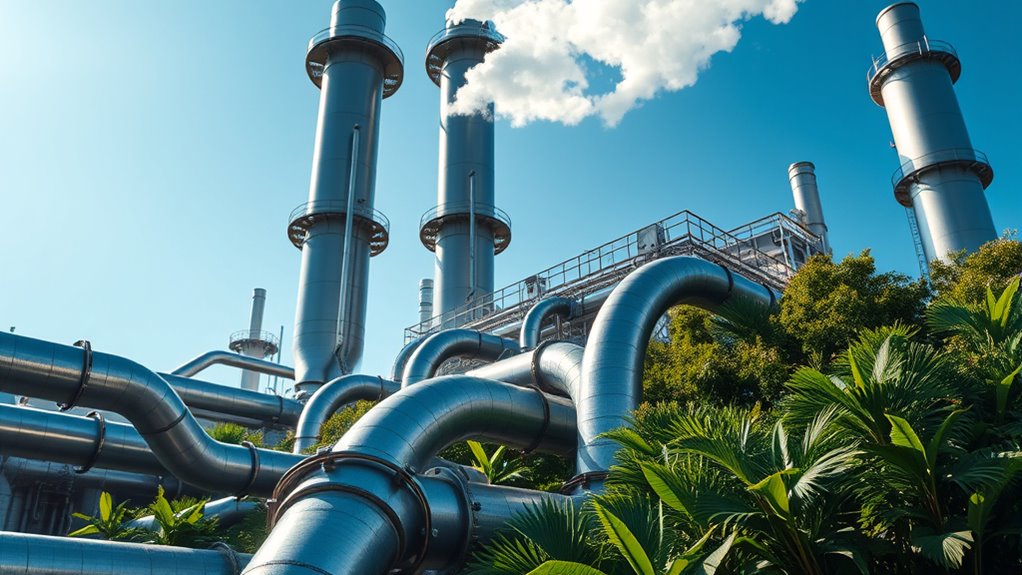
Carbon capture technology hinges on a simple yet effective principle: it removes CO2 from the atmosphere or industrial processes before it can contribute to climate change. This process involves capturing carbon dioxide emissions directly from sources like power plants or even from the air itself.
You'll find that this technology uses various methods, including chemical absorption, where CO2 binds with specific solvents. Once captured, the CO2 can be compressed and stored underground or repurposed for other uses.
Understanding the science behind this technology is crucial, as it plays a significant role in reducing greenhouse gas emissions. By actively engaging with these methods, you contribute to a more sustainable future and help combat the ongoing climate crisis.
Breakthrough Materials for CO2 Absorption

Recent advancements have led to the development of innovative materials that significantly enhance CO2 absorption capabilities.
You'll find that these breakthrough materials, such as metal-organic frameworks (MOFs) and advanced amine solutions, offer higher efficiency and selectivity compared to traditional methods.
MOFs, with their high surface area and tunable structures, can capture large volumes of CO2 under varying conditions.
MOFs, featuring impressive surface areas and customizable structures, excel at capturing substantial amounts of CO2 across diverse conditions.
On the other hand, enhanced amine solutions improve reaction kinetics, making them quicker and more effective.
These materials not only lower the energy costs associated with carbon capture but also increase the overall sustainability of the process.
Direct Air Capture: A Game Changer
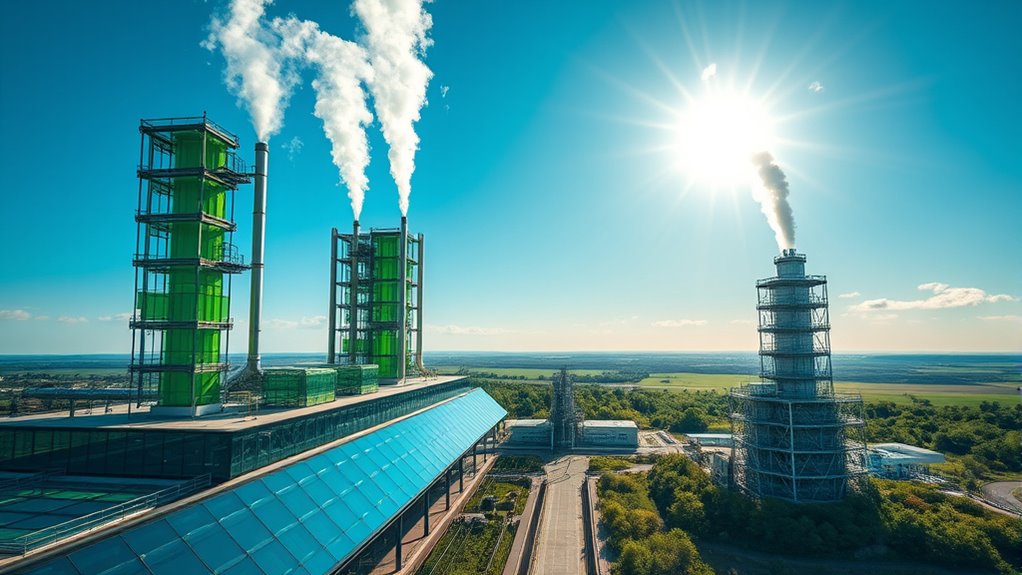
As the urgency to combat climate change intensifies, direct air capture (DAC) emerges as a revolutionary solution. This innovative technology allows you to remove carbon dioxide directly from the atmosphere, offering a proactive approach to reducing greenhouse gas concentrations.
With DAC systems, you can capture emissions that traditional methods often overlook. These systems use chemical processes to absorb CO2 from the air, making it easier for you to address the climate crisis.
Transforming Captured Carbon Into Useful Products
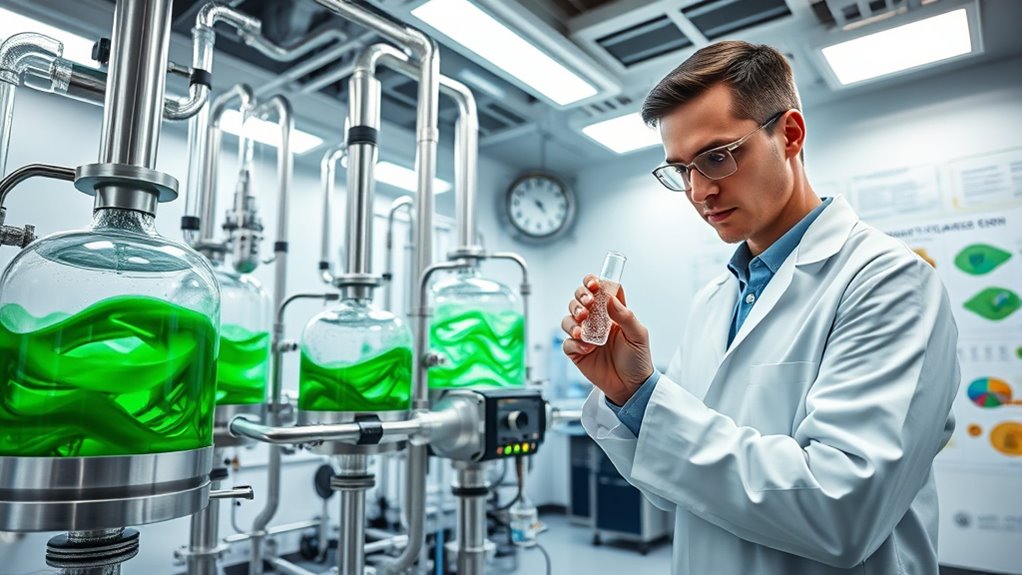
A promising avenue in the fight against climate change is transforming captured carbon into useful products. By repurposing CO2, you can help create materials like plastics, fuels, and even concrete. This not only reduces greenhouse gases but also provides sustainable alternatives to traditional manufacturing processes.
For instance, companies are developing methods to convert CO2 into synthetic fuels, allowing you to power vehicles while minimizing emissions. Additionally, some innovations focus on turning carbon into building materials, which can sequester carbon for extended periods.
Engaging in these initiatives not only supports the environment but also drives economic growth. By investing in and promoting these technologies, you can contribute to a circular economy that values sustainability and innovation, making a tangible impact on climate change.
Innovations in Carbon Capture Processes
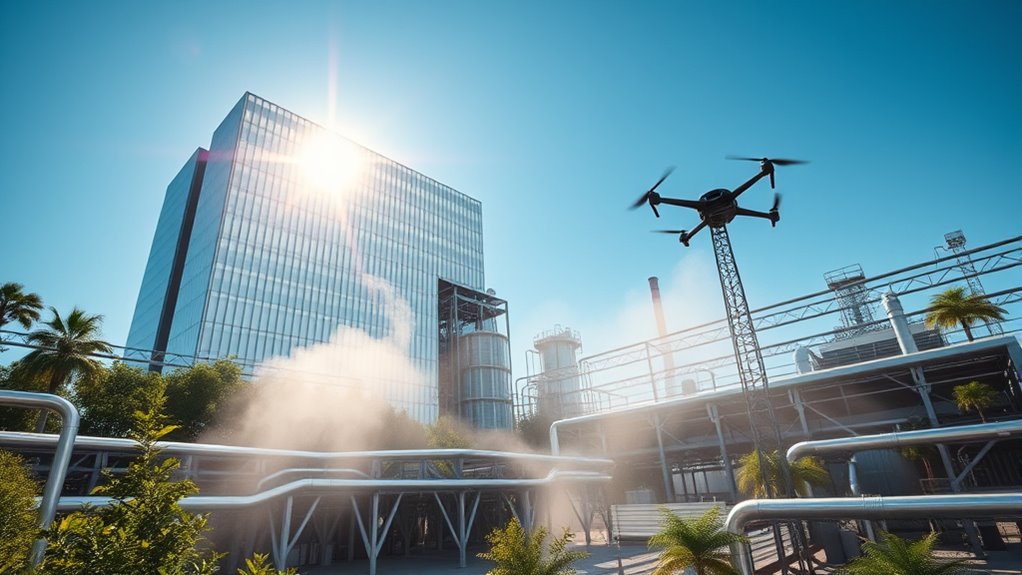
How can innovative processes enhance carbon capture efficiency? By adopting advanced techniques like direct air capture (DAC) and membrane separation, you can significantly improve the effectiveness of carbon capture systems.
DAC technology pulls CO2 directly from the atmosphere, allowing you to target emissions more precisely. Membrane separation uses selective barriers to separate CO2 from other gases, which can streamline the process and reduce energy consumption.
Additionally, integrating machine learning algorithms can optimize capture rates by predicting CO2 concentrations in real-time.
You also might explore the use of bio-inspired methods, such as utilizing algae or other microorganisms for their natural carbon absorption capabilities.
These innovations not only improve efficiency but also make carbon capture more sustainable and cost-effective.
Integration With Renewable Energy Sources
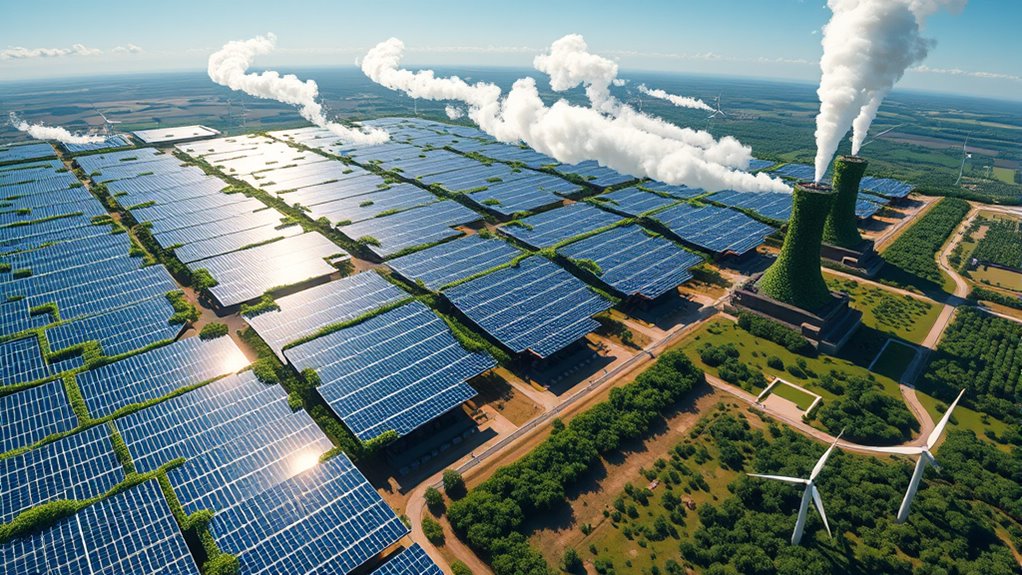
While integrating carbon capture technology with renewable energy sources can enhance overall efficiency, it also creates a more sustainable approach to managing greenhouse gas emissions.
By harnessing wind, solar, or hydroelectric power, you can reduce the energy demands of carbon capture systems, making them more viable. This synergy not only minimizes the carbon footprint of the capture process itself but also maximizes the benefits of renewable energy.
Harnessing renewable energy significantly lowers the energy needs of carbon capture systems, enhancing their efficiency and sustainability.
For instance, utilizing excess energy from solar panels during peak production times can power carbon capture units, ensuring that you're capturing more CO2 without additional fossil fuel consumption.
This integration can lead to a circular economy where captured carbon is repurposed, further promoting sustainability and reducing reliance on traditional energy sources.
Economic Impacts and Market Potential

As the demand for sustainable solutions grows, the economic impacts and market potential of carbon capture technology are becoming increasingly significant.
Investing in carbon capture not only mitigates climate change but also creates jobs and stimulates economic growth. You'll find that industries are recognizing the value of this technology in meeting regulatory requirements and enhancing their corporate responsibility.
With carbon pricing mechanisms gaining traction, businesses that adopt these technologies early can gain a competitive edge. Furthermore, the emergence of new markets for captured carbon, such as in enhanced oil recovery and sustainable products, opens additional revenue streams.
Ultimately, embracing carbon capture can lead to a more resilient economy while contributing to global sustainability goals.
Case Studies of Successful Carbon Capture Projects

Carbon capture technology has already demonstrated its potential through several successful projects around the globe, showcasing practical applications that inspire further adoption.
For instance, the Boundary Dam project in Canada has successfully captured over a million tons of CO2 annually since its launch.
Similarly, Norway's Sleipner project has been capturing CO2 from natural gas production since 1996, injecting it into a geological formation beneath the North Sea.
In the United States, the Petra Nova project captures CO2 from a coal-fired power plant, which is then utilized for enhanced oil recovery.
These projects prove that carbon capture can significantly reduce emissions while providing valuable resources, encouraging you to consider its broader implementation in various industries.
Future Trends and Challenges in Carbon Capture Technology

Although the potential for carbon capture technology is promising, several trends and challenges loom on the horizon.
You'll notice increasing investments in research and development aimed at enhancing efficiency and reducing costs. However, scalability remains a significant hurdle; many methods still struggle to be implemented on a large scale.
The regulatory landscape is also evolving, which could either facilitate or hinder progress. Public perception plays a crucial role too; you'll need to engage communities and stakeholders to gain support.
Additionally, advancements in materials and processes are essential, but they often require time and funding.
As you navigate these trends and challenges, staying informed and adaptable will be key to successfully implementing carbon capture solutions in the future.
Frequently Asked Questions
What Are the Main Environmental Benefits of Carbon Capture Technology?
Carbon capture technology offers several key environmental benefits.
It significantly reduces greenhouse gas emissions, helping combat climate change by preventing CO2 from entering the atmosphere.
You'll also notice improved air quality, as capturing carbon can lower pollutants that contribute to smog and respiratory issues.
Additionally, it promotes sustainable energy practices, enabling you to harness fossil fuels while minimizing their environmental impact.
How Does Carbon Capture Impact Local Communities and Economies?
Imagine a shield protecting your neighborhood from pollution.
Carbon capture can significantly impact local communities and economies by improving air quality and public health. When emissions decrease, you breathe easier and enjoy a cleaner environment.
Additionally, these technologies can create jobs in installation and maintenance, boosting local economies. You might find new opportunities in emerging green sectors, fostering community resilience while contributing to a sustainable future for everyone.
What Is the Lifespan of Carbon Capture Technologies?
The lifespan of carbon capture technologies varies based on design and maintenance, but you can generally expect them to last anywhere from 10 to 30 years.
Regular upkeep and timely upgrades can extend their efficiency and effectiveness.
You should also consider that advancements in the field may lead to newer, more efficient systems, prompting you to evaluate whether to invest in upgrading or replacing older technologies as they reach the end of their operational life.
Are There Any Health Risks Associated With Carbon Capture?
When you think about carbon capture, it's easy to imagine a clean, hopeful future.
However, there are potential health risks to consider. You might encounter concerns about exposure to certain chemicals used in the process.
While the technology aims to reduce emissions, it's crucial to stay informed about any possible impacts on air quality and surrounding ecosystems.
Knowing the facts helps you make educated decisions about the balance between progress and safety.
How Can Individuals Contribute to Carbon Capture Efforts?
You can contribute to carbon capture efforts in several ways.
Start by reducing your carbon footprint—use public transport, recycle, and conserve energy.
Support local initiatives focused on reforestation and sustainable practices.
Consider investing in companies that prioritize carbon capture technologies.
Educate others about the importance of reducing carbon emissions.
Every action counts, so even small changes in your daily life can make a significant difference in the fight against climate change.
Conclusion
As you reflect on the innovations in carbon capture technology, consider how these advancements are like seeds planted in fertile soil, promising a greener future. By harnessing breakthrough materials and processes, we're not just capturing carbon; we're transforming it into valuable resources and integrating it with renewable energy. The economic potential is vast, and with successful case studies paving the way, the future of carbon capture holds hope for a cleaner, more sustainable planet.
